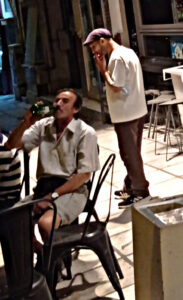Mouschoundi Square
City
Migration Period
City Narratives
Category
Full Description
Mouschoundi Square has been pivotal to Thessaloniki’s evolution, both from an urban planning standpoint and the perspective of anthropogeography. On the intersection of what today is 3 Olympiados Street and Sachini Street stood the house where the fire that would raze about two thirds of the city lying within the walls started at five in the afternoon of August 18, 1917. Within 32 hours, the blaze had burned down 9,500 houses across 100 hectares, leaving more than 70,000 people homeless. The fire heavily impacted the city’s Jewish community and, to a lesser extent, the Muslim community, while the Greek Christian neighbourhoods were barely affected. Across from the house where the fire started was a water pump called Horhor su (‘burbling water’ in Turkish) which has not survived.
Today, Mouschoundi Square is the entrance to the centre of the city from the areas of Sykies, Neapoli and western Ano Poli. It is frequented by local residents originating from Eastern Europe and the countries of the former Soviet Union as well as newly arrived migrants from Syria and northern Africa. Neighbourhood shops, improvised open-air cafés where residents bring their own chairs and tables, fresh laundry hanging over the grey facades of apartment blocks, the few remaining ‘kastroplikta’ (dwellings built against the Byzantine walls), the shuttered shops of the old vegetable market complex on the south part of the square; all these disparate elements come together to constitute a distinctive landscape that functions as a gateway into the time, space and anthropogeography of the city.
It is noteworthy that the square was named after Nikolaos Mouschoundis (1906-1958), who served as a police colonel from the interwar period until the 1950s. Mouschoundis was a controversial figure due to his extensive anticommunist activities and his participation in the suppression of the May 1936 uprising. He was also in charge of the investigation into the assassination of the American journalist George Polk, during which he wrongly accused journalist Grigoris Staktopoulos for colluding with Polk’s murderers and tortured him to extract a confession. During the Nazi occupation, he helped several members of the resistance escape, but during the Greek civil war, he undertook the task of dismantling the organizations People’s Mass Self-Defense (MLA) and Protection Team for People’s Self-Defense (OPLA). All things considered, Mouschoundis was particularly popular among the locals. He was a lover of ‘rebetiko’ music (it is rumoured that he had more than 5,000 ‘rebetiko’ records), he was Vasilis Tsitsanis’ best man, and many artists of the time, such as Tsitsanis, Ilias Petropoulos and Markos Vamvakaris, spoke highly of him.
Bibliography
Aleka Karadimou-Yerolympos, The reconstruction of Thessaloniki after the Great Fire of 1917. A landmark in the history of the city and the development of Greek urban planning, University Studio Press, Thessaloniki 1995.
Rizos Kaiafas, Nikolaos Mouschoundis (1906-1958). The life and work of the ingenious Thessaloniki police officer, postgraduate dissertation, School of History and Archaeology, Aristotle University of Thessaloniki, 2006.








